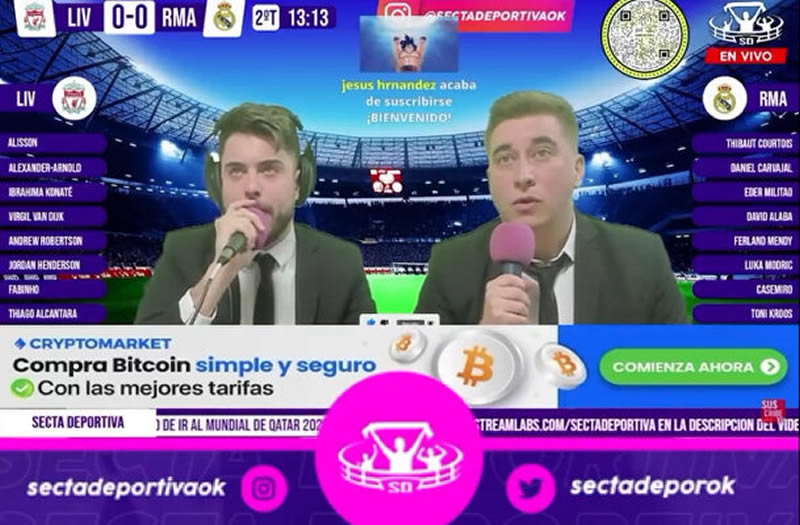The new paradigm of communication in the digital era is not fully explained without detailing the phenomenon of the proliferation of streaming channels that are mounted to events in the public domain.

On Saturday of the Champions League final between Real Madrid and Borussia Dortmund, the YouTube channel of “La Secta Deportiva” made an eight-hour broadcast with the pre-match, match and post-match analysis. A mega coverage for what became the 15th Champions League won by the Spanish team.
Twenty-four hours after the match, the channel accumulated 1.3 million views. There is another essential fact that deserves to be known: at no time during the eight hours of transmission was any game action seen. Only chatter, reports and commentaries. No goals or Vinicius’ masterful goal kick. Just words.
The phenomenon is recurrent on platforms such as YouTube, Twitch and probably Kick, another terminal for content creators that joins this digital ecosystem with force. La Secta Deportiva is a channel connected to YT since May 2015, with more than 2,000 videos published -most of them live-, a base of 1.6 million subscribers and 137,688,623 views of the published content. In no case were videos containing images for which royalties are paid. All the content presented dispensed with that kind of material.
This is a self-managed group that creates a digital soccer channel and deploys its potential outside the traditional communication structures. A low-cost formula with high impact in different markets. Conversations, stories and commentaries. Radio with image. The chat channel to give life to the interaction with the follower and loyal community.
The new paradigm of communication in the digital era cannot be fully explained without detailing this type of phenomena: the proliferation of streaming channels that are mounted on events in the public domain. Soccer is just one more ingredient of everything that mobilizes a streamer, tiktoker or youtuber to give his own version of the story.

The great novelty in this story is the creation of a sports audience that consumes content, participates, pays subscriptions, thanks with emojis and “gifts”, based on videos and programs that at no time connect with the system of negotiation of sports rights. A communicational ecosystem born and developed under the democratization of technology that caused the great paradigm shift of this century that has been going on for almost 25 years: that consumers can also be creators.
The mainstream sports industry, the one that negotiates rights, has here an issue that keeps it awake at night and generates concern. Generation Z actively participates in the consumption of sports content for which they literally do not spend a penny to be part of a party that costs a lot of money.
Let’s imagine a common family scene: the father, a soccer fan, pays for a premium package to watch the games on TV. After the match, the youngsters in the house don’t stick around to watch the post-match analysis on traditional channels. Instead, they turn to YouTube to watch a popular streamer’s reactions and commentary, ignoring so-called mainstream content altogether. This situation reflects a significant transition: young people enter the official system only to watch the match paid for by the elders, who manage the household economy.
This change in consumption becomes even more radical if we consider that many young people choose to watch the game through pirate transmissions, which imply millionaire losses for the industry. Or through streaming channels that offer live coverage and commentary, without the need for images. It’s like a modern version of radio, but with video and interactive chat.
This Generation Z consumption cycle does not connect with the ecosystem that pays broadcasting rights and seeks to monetize in multiple ways. A second screen that is actually the first -and only- for a profile of fans that are incorporated into the sports show through digital communities outside the mainstream.
Content creators, who generate a large part of the material consumed by young people, do not contribute financially to sports rights holders. This content leaves no revenue for leagues or sports properties. But with its operation alone, with the amount of views that are accumulated, they give a convincing demonstration of how attractive and appealing traditional sports continue to be for the new generations who, it is said, could live without such consumption. It is clear that not so much.
It is not a lack of interest shown by Gen Z, but it forces an incessant search for a suitable business model. Of course, rights licensees and traditional media have caught the signals of this phenomenon and the creation of additional content, streamer sessions and “watch parties” to connect with this new form of entertainment that has soccer and sports as an input is already recurrent.
A rights negotiator in soccer leagues reflects: “I imagine that when Generation Z is over 40 years old, they will also want to enjoy the games on TV without interruptions. But we don’t know for sure yet.” This uncertainty highlights the need for leagues and broadcasters to adapt and find new ways to capture the attention and revenues of future generations of soccer fans.
The Champions League final in London proved that live soccer is a valuable and desired asset. What is also happening is that there are new generations that can come into contact with this subject of interest in an alternative way.